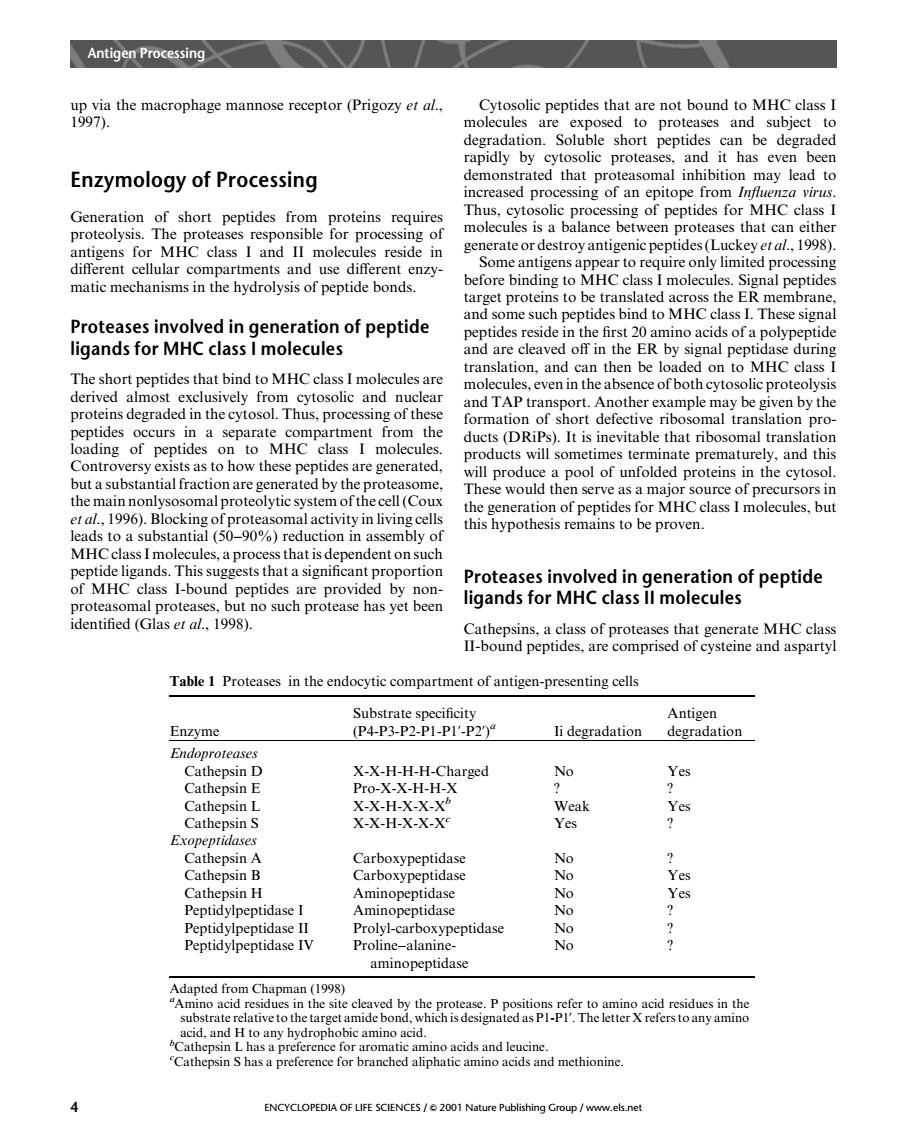正在加载图片...

Antig Proeing Cytosolic peptides that are not bound to MHC class I molecules are short peptides can be degraded eve Enzymology of Processing al ink Thus,eytosolic processing of peptides for MHC class I es that can e for MHC class I and II mole s residi 998 different cellular compartments and use different enzy before binding to MHC class I molecules.Signal peptides matic mechanisms in the hydrolvsis of peptide bonds. ome st ese signa Proteases involved in generation of peptide ligands for MHC class I molecules d off in the ER bys translation.and can then be loaded on to MHC class cytosolic and nucle nolecules.even in the absence of both cvto proteins degraded in the cytosol.Thus,processing of these and TAP transport.Another example may be give n by the rtment from the ducts (DRiPs)It is ine xists mole oroducts will sometimes terminate prematurely.and this but a substantial fraction are generated by the protea ser the main nonlysosomal proteolytic system ofthecell(Coux of prec eal.1996. activity niv ss I molecules MHC su ofI-bound Proteases involved in generation of peptide no such protease has yet beer ligands for MHC class ll molecules Cathepsins,a class of proteases that generate MHC class II-bound peptides.are comprised of cysteine and aspartyl Table 1 Proteases in the endocytic compartment of antigen-presenting cells Enzyme li degradation Endoprotease X-X-H-H- No Yes Cathepsin S X-X-H-X-X-X Yes Exopeptidases Aminopeptidase No Peptidylpeptidase Il Prolyl-carboxypeptidase Peptidylpeptidase I Proli No aminopeptidase Adaptd from Chapmn(1) ENCYCLOPEDIA OF LIFE SCIENCES/ wels netup via the macrophage mannose receptor (Prigozy et al., 1997). Enzymology of Processing Generation of short peptides from proteins requires proteolysis. The proteases responsible for processing of antigens for MHC class I and II molecules reside in different cellular compartments and use different enzymatic mechanisms in the hydrolysis of peptide bonds. Proteases involved in generation of peptide ligands for MHC class I molecules The short peptides that bind to MHC class I molecules are derived almost exclusively from cytosolic and nuclear proteins degraded in the cytosol. Thus, processing of these peptides occurs in a separate compartment from the loading of peptides on to MHC class I molecules. Controversy exists as to how these peptides are generated, but a substantial fraction are generated by the proteasome, the main nonlysosomal proteolytic system of the cell (Coux et al., 1996). Blocking of proteasomal activity in living cells leads to a substantial (50–90%) reduction in assembly of MHC class I molecules, a process that is dependent on such peptide ligands. This suggests that a significant proportion of MHC class I-bound peptides are provided by nonproteasomal proteases, but no such protease has yet been identified (Glas et al., 1998). Cytosolic peptides that are not bound to MHC class I molecules are exposed to proteases and subject to degradation. Soluble short peptides can be degraded rapidly by cytosolic proteases, and it has even been demonstrated that proteasomal inhibition may lead to increased processing of an epitope from Influenza virus. Thus, cytosolic processing of peptides for MHC class I molecules is a balance between proteases that can either generate or destroy antigenic peptides (Luckey et al., 1998). Some antigens appear to require only limited processing before binding to MHC class I molecules. Signal peptides target proteins to be translated across the ER membrane, and some such peptides bind to MHC class I. These signal peptides reside in the first 20 amino acids of a polypeptide and are cleaved off in the ER by signal peptidase during translation, and can then be loaded on to MHC class I molecules, even in the absence of both cytosolic proteolysis and TAP transport. Another example may be given by the formation of short defective ribosomal translation products (DRiPs). It is inevitable that ribosomal translation products will sometimes terminate prematurely, and this will produce a pool of unfolded proteins in the cytosol. These would then serve as a major source of precursors in the generation of peptides for MHC class I molecules, but this hypothesis remains to be proven. Proteases involved in generation of peptide ligands for MHC class II molecules Cathepsins, a class of proteases that generate MHC class II-bound peptides, are comprised of cysteine and aspartyl Table 1 Proteases in the endocytic compartment of antigen-presenting cells Enzyme Substrate specificity (P4-P3-P2-P1-P1’-P2’) a Ii degradation Antigen degradation Endoproteases Cathepsin D X-X-H-H-H-Charged No Yes Cathepsin E Pro-X-X-H-H-X ? ? Cathepsin L X-X-H-X-X-Xb Weak Yes Cathepsin S X-X-H-X-X-Xc Yes ? Exopeptidases Cathepsin A Carboxypeptidase No ? Cathepsin B Carboxypeptidase No Yes Cathepsin H Aminopeptidase No Yes Peptidylpeptidase I Aminopeptidase No ? Peptidylpeptidase II Prolyl-carboxypeptidase No ? Peptidylpeptidase IV Proline–alanineaminopeptidase No ? Adapted from Chapman (1998) a Amino acid residues in the site cleaved by the protease. P positions refer to amino acid residues in the substrate relative to the target amide bond, which is designated as P1-P1’. The letter X refers to any amino acid, and H to any hydrophobic amino acid. b Cathepsin L has a preference for aromatic amino acids and leucine. c Cathepsin S has a preference for branched aliphatic amino acids and methionine. Antigen Processing 4 ENCYCLOPEDIA OF LIFE SCIENCES / & 2001 Nature Publishing Group / www.els.net